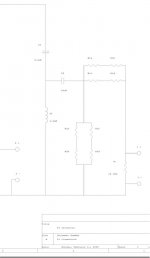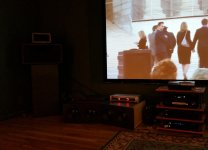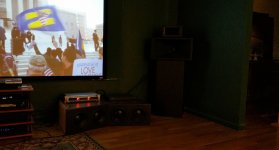XO debug
 Working on the XO is a good idea. The crossover between the two drivers itself looks fine but the constant directivity compensation looks way off.
Working on the XO is a good idea. The crossover between the two drivers itself looks fine but the constant directivity compensation looks way off.
I attached part of the XO schematic from around the CD terminals. Wayne P can tell you the equivalent resistance you should see looking into those terminals with a VOM. Its easy enough to analyze but I don't have the R values handy. If I recall correctly, it provides a fixed attenuation to match the sensitivity of the mid with an effective impedance to match the CD's Z. So you don't need to ask Wayne, just look for an R value matching the Z rating of your CD. If you measure the right resistance there, chances are high that all of those resistors are good. If not you need to check individual Rs... You can buy a VOM (volt ohm milliameter) at Radio Shack, Home Depot, and most electrical supply shops for circa $40.
Also check C3. C3 is responsible for decreasing attenuation as frequency rises tp bring up the missing high end. If C3 is the wrong value, this effect will start at the wrong frequency. If it is shorted, it won't happen at all. A wrong R value will also change the break frequency but will also change the amount of attenuation. If you have no means of checking C3 other than for a short, simply get a new one and replace it.
Hope that helps and I didn't insult your intelligence. No guarantees of course. The above is just an educated guess and chances are I spoke too quickly.
 Working on the XO is a good idea. The crossover between the two drivers itself looks fine but the constant directivity compensation looks way off.
Working on the XO is a good idea. The crossover between the two drivers itself looks fine but the constant directivity compensation looks way off.I attached part of the XO schematic from around the CD terminals. Wayne P can tell you the equivalent resistance you should see looking into those terminals with a VOM. Its easy enough to analyze but I don't have the R values handy. If I recall correctly, it provides a fixed attenuation to match the sensitivity of the mid with an effective impedance to match the CD's Z. So you don't need to ask Wayne, just look for an R value matching the Z rating of your CD. If you measure the right resistance there, chances are high that all of those resistors are good. If not you need to check individual Rs... You can buy a VOM (volt ohm milliameter) at Radio Shack, Home Depot, and most electrical supply shops for circa $40.
Also check C3. C3 is responsible for decreasing attenuation as frequency rises tp bring up the missing high end. If C3 is the wrong value, this effect will start at the wrong frequency. If it is shorted, it won't happen at all. A wrong R value will also change the break frequency but will also change the amount of attenuation. If you have no means of checking C3 other than for a short, simply get a new one and replace it.
Hope that helps and I didn't insult your intelligence. No guarantees of course. The above is just an educated guess and chances are I spoke too quickly.
Last edited:
Nothing wrong with the 4x10 DSP, but it takes a lot more than moving xover points and levels around by ear to do that right, especially with horns and waveguides. It sure seems like there must have been something wildly wrong with the passive xover wiring or boards if that sounds better, but that's really for you and Wayne to work out, or not.
Yup. Kind of daunting to say the least.
The good news is that I am up and working and things sound okay.
And that is a great place to START!
Crossovers set at 250 and 1600 with 12db slopes. Mids/highs set to an Outlaw Audio 7075 (75wx5) and lows to two Outlaw 2200 (200w) amps. Mids/highs dropped 11db.
The weird phase problems are gone and they don't offend my ears anymore.
I have been reading up on how to measure and properly set up. Lots to learn!
Thanks again for pointing out the Octaves things a while back.
Vince
The good news is that I am up and working and things sound okay.
And that is a great place to START!
Crossovers set at 250 and 1600 with 12db slopes. Mids/highs set to an Outlaw Audio 7075 (75wx5) and lows to two Outlaw 2200 (200w) amps. Mids/highs dropped 11db.
The weird phase problems are gone and they don't offend my ears anymore.
I have been reading up on how to measure and properly set up. Lots to learn!
Thanks again for pointing out the Octaves things a while back.
Vince
John Nolte of Nolte Audio came over and set up my XO the old school way with driver specs in hand. After many hours of measuring and listening he ended up where Wayne recommended as far as XO points. We (he) played with levels and slopes until he thought it was right. The man has a good ear and lots of knowledge!
After spending a full day we out to dinner, then came back to listen for a while..
Wow. I ended up with the system I wanted. Very easy to listen to as well as very musical. We haven't done anything with EQ at all and I could walk away right now and be very happy.
It's been a journey but in the end I have learned a whole bunch and have a DSP to play with and learn about. That should give my OCD something to do for a while.
I also ended up with a Nolte two box Sub system with 4x10" drivers in each box. They weigh close to 175Lbs each and are flat to 24Hz. Crazy stuff indeed.
Vince
After spending a full day we out to dinner, then came back to listen for a while..
Wow. I ended up with the system I wanted. Very easy to listen to as well as very musical. We haven't done anything with EQ at all and I could walk away right now and be very happy.
It's been a journey but in the end I have learned a whole bunch and have a DSP to play with and learn about. That should give my OCD something to do for a while.
I also ended up with a Nolte two box Sub system with 4x10" drivers in each box. They weigh close to 175Lbs each and are flat to 24Hz. Crazy stuff indeed.
Vince
Vince,John Nolte of Nolte Audio came over and set up my XO the old school way with driver specs in hand. After many hours of measuring and listening he ended up where Wayne recommended as far as XO points. We (he) played with levels and slopes until he thought it was right. The man has a good ear and lots of knowledge!
It's been a journey but in the end I have learned a whole bunch and have a DSP to play with and learn about. That should give my OCD something to do for a while.
As you have found out, getting the crossover right is about 1/2 of of a speaker design, proper implementation can get phase and frequency response very good even with relatively inexpensive drivers.
Unfortunately, DSP can't change dispersion patterns, the waistbanding (narrowing pattern before widening) the lack of a secondary horn expansion on the mids in your cabinets can't be corrected without physically adding one on.
Fortunately, Bwaslo has made a calculator based on the work of Don Keele that helps to figures the angles needed for the addition of a secondary horn expansion for any four sided conical horn:
http://libinst.com/SynergyCalc/Synergy Calc V5.pdf
Have fun listening (and learning)!
Art
Last edited:
Measured the distance between sub voice coils and cornerhorn drivers and added delay to the three drivers (each). The mains woofer had a bit over 4ms and then down from there. Doing a one, two comparison the first thing I noticed was that the subs disappeared! I now have good stereo bass. The second thing was that the mids/highs really started resolving well and I can no longer pinpoint the drivers with my ears.
All good things.
All good things.
I'm not sure if waistbanding is really an issue here, at least with the original filter functions, given the corner placement plus the broad overlap with the cornerhorn bass..
The mid horns do not connect with the corner sidewalls, so waistbanding and the lower frequency diffraction reflecting off the walls is an issue "here" or anywhere they will be used.
Now that Compaddict has resolved the major issues of phase and time alignment, the more minor issues of non uniform dispersion and diffraction cause may be more apparent.
That said, he may finally just say "good enough" and just start enjoying the music, as a room's size, shape, volume and the furnishings within cause plenty of problems with a speaker's response that easily could be far more noticeable, and can never be addressed without major changes.
I know what could be done in my listening/recording room to make it even better sounding, but doing those changes would compromise the other usual uses too much for me (and Bonnie's) taste.
Art
It's not a mid cornerhorn, so mating perfectly to the walls isn't on the table. It's rather a question of whether things are successfully dealt with in the crossover (original xover obviously not functioning as designed and abandoned due to unresolved issues) which is around the waistbanding region, and whether the reflections are more or less of a problem than the new ones that extending the horn would introduce. Given that the designer uses the term "waistbanding" frequently, I would think that's been fully considered, but I might be wrong. It's a pretty old design at this point.The mid horns do not connect with the corner sidewalls, so waistbanding and the lower frequency diffraction reflecting off the walls is an issue "here" or anywhere they will be used.
It is clear from the posts here that Compaddict has no idea how to do that (no offense intended whatsoever), so whether that is true depends entirely on whether the helper did that properly, or sort of properly, or not at all.Now that Compaddict has resolved the major issues of phase and time alignment, the more minor issues of non uniform dispersion and diffraction cause may be more apparent.
To be clear, this isn't a speaker design I think I want to build, nor do I want to design something very similar, and also it's a sure thing that better performance than the original design is possible with DSP. I just think the original design was sold pretty short by this thread.
Last edited:
I've got Pi 7's and have had for years (since the '90's). When I started with mine they were about 8 cubic foot 2 way designs. Todays version is an old design that has been updated. They are great speakers, but I like Klipschorns too so consider the source if you are reading this.
Compaddict: Congrats on your speakers. It's too bad we don't have a way to share hearing them. That would address some of the comments being made.
Grant.
Compaddict: Congrats on your speakers. It's too bad we don't have a way to share hearing them. That would address some of the comments being made.
Grant.
- Status
- This old topic is closed. If you want to reopen this topic, contact a moderator using the "Report Post" button.
- Home
- Loudspeakers
- Multi-Way
- Thinking about Pi 7 kit..

